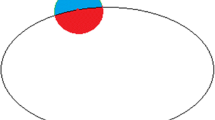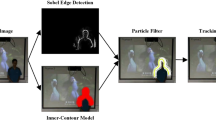Abstract
We present a lip contour tracking algorithm using attractor-guided particle filtering. Usually it is difficult to robustly track the lip contour because the lip contour is highly deformable and the contrast between skin and lip colors is very low. It makes the traditional blind segmentation-based algorithms often fail to have robust and realistic results. But in fact, the lip contour is constrained by the facial muscles, the tracking configuration space can then be represented by a lower dimensional manifold. With this observation, we take some representative lip shapes as the attractors in the lower dimensional manifold. To resolve the low contrast problem, we adopt a color feature selection algorithm to maximize the separability between skin and lip colors. Then we integrate the shape priors and the discriminative feature into the attractor-guided particle filtering framework to track the lip contour. The experimental result shows that we can track the lip contour robustly and efficiently.
Preview
Unable to display preview. Download preview PDF.
Similar content being viewed by others
References
Oliver, N., Pentland, A., Berard, F.: Lafter: a real-time face and lips tracker with facial expression recognition. Pattern Recognition 33, 1369–1382 (2000)
Zhang, X., Mersereau, R.M., Clements, M., Broun, C.C.: Visual speech feature extraction for improved speech recognition. In: Proc. of IEEE Internation Conference on Acoustic, Speech and Signal Processing (2002)
Kass, M., Witkin, A., Terzopoulos, D.: Snakes: Active contour models. International Journal of Computer Vision, 321–331 (1988)
Chan, M.T.: Automatic lip model extraction for constrained contour-based tracking. In: Proc. of IEEE International Conference on Image Processing (1999)
Wakasugi, T., Nishiura, M., Fukui, K.: Robust lip contour extraction using separability of multi-dimensional distribution. In: Proc. of IEEE International Conference on Automatic Face and Gesture Recognition (2004)
Eveno, N., Caplier, A., Coulon, P.Y.: Accurate and quasi-autimatic lip tracking. IEEE Trans. on Circuits and Systems for Video Technology 14, 706–715 (2004)
Cootes, T., Taylor, C., Cooper, D., Graham, J.: Active shape models: Their training and application. Computer Vision and Image Understanding 61, 38–59 (1995)
Matthews, I., Cootes, T.F., Bangham, J.A., Cox, S., Harvey, R.: Extraction of visual features for lipreading. IEEE Trans. on Pattern Analysis and Machine Intelligence 24, 198–213 (2002)
Isard, M., Blake, A.: Condensation–conditional density propagation for visual tracking. International Journal of Computer Vision 29, 5–28 (1998)
MacCormick, J., Isard, M.: Partition sampling, articulated objects and interface-quality hand tracking. In: Proc. of European Conference of Computer Vision (2000)
Wu, Y., Lin, J.Y., Huang, T.S.: Capturing natural hand articulation. In: Proc. of IEEE International Conference on Computer Vision (2001)
Chang, W.Y., Chen, C.S., Hung, Y.P.: Appearance-guided particle filtering for articulated hand tracking. In: Proc. of IEEE International Conference on Computer Vision and Pattern Recognition (2005)
Chiou, G.I., Hwang, J.N.: Lipreading from color video. IEEE Trans. on Image Processing 6, 1192–1195 (1997)
Collins, R.T., Liu, Y.: On-line selection of discriminative tracking features. In: Proc. of IEEE International Conference on Computer Vision (2003)
Kaucic, R., Blake, A.: Accurate, real-time, unadorned lip tracking. In: Proc. of International Conference on Computer Vision (1998)
Jones, M., Rehg, J.: Statistical color models with application to skin detection. International Journal of Computer Vision 46, 81–96 (2002)
Author information
Authors and Affiliations
Editor information
Editors and Affiliations
Rights and permissions
Copyright information
© 2006 Springer-Verlag Berlin Heidelberg
About this paper
Cite this paper
Jian, YD., Chang, WY., Chen, CS. (2006). Attractor-Guided Particle Filtering for Lip Contour Tracking. In: Narayanan, P.J., Nayar, S.K., Shum, HY. (eds) Computer Vision – ACCV 2006. ACCV 2006. Lecture Notes in Computer Science, vol 3851. Springer, Berlin, Heidelberg. https://doi.org/10.1007/11612032_66
Download citation
DOI: https://doi.org/10.1007/11612032_66
Publisher Name: Springer, Berlin, Heidelberg
Print ISBN: 978-3-540-31219-2
Online ISBN: 978-3-540-32433-1
eBook Packages: Computer ScienceComputer Science (R0)




